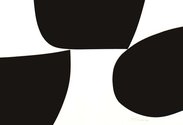John Hurrell – 21 September, 2009
1969 was his Frances Hodgkins year and his career really too took off after that - especially with the glossy black lacquer, minimalist panels with glowing lines (they are the peak of his career), and the wonderful textual collaborations with Tuwhare and Manhire.
This is a preview exhibition for an auction of sixty Hotere items that make up a collection of work he gifted to Annette Ferguson. They are mostly works on paper, namely drawings and prints, with a couple of very early shaped canvases. The earliest work is 1957, the latest 1968.
1969 was his Frances Hodgkins year and his career really too took off after that - especially with the glossy black lacquer, minimalist panels with glowing lines (they are the peak of his career), and the wonderful textual collaborations with Tuwhare and Manhire. However he did do the Sangro (1962-3) and the Polaris and Algerie series during the earlier period of these about-to-be-auctioned works.
The trouble with Hotere is you have pick really carefully through his work to get to the good stuff. Over the years he has produced an awful lot of dross, particularly on paper, and in that way this collection is typical - especially with works that owe a lot to his friend McCahon. However you can tell he is experimenting to find a voice, indeed struggling - testing out ideas, looking at Kelly, Pasmore, Frost and others. So although most of the work here does not age well - it looks like shabby design - it is interesting to see it as samples of a process (some unsigned) that did occasionally lead to brilliance.
Art & Object’s little catalogue of essays is useful for a group of short texts by David Eggleton, Kriselle Baker, Oliver Stead and house staff that elucidate the context, especially the different series of protest paintings. Yet looking at larger survey publications like the recent Baker/O’Sullivan tome is also a good way to supplement this material, examining the non-paper paintings that developed at the same time and seeing where Hotere’s testing of new formal and political ideas led him.
However that approach denies the unique qualities that a handful of these paper works possess. Their surface properties are not found on soft canvas or hardboard or metal panel, especially those sheets with light and feathery, painted brush marks, scumbled monoprinting, or deliberately out of register screenprinting. You have to go to the Art & Object space yourself, zero in on what catches your eye, ignore the copious rubbish and look closely.







 Advertising in this column
Advertising in this column Two Rooms presents a program of residencies and projects
Two Rooms presents a program of residencies and projects



This Discussion has 0 comments.
Comment
Participate
Register to Participate.
Sign in
Sign in to an existing account.